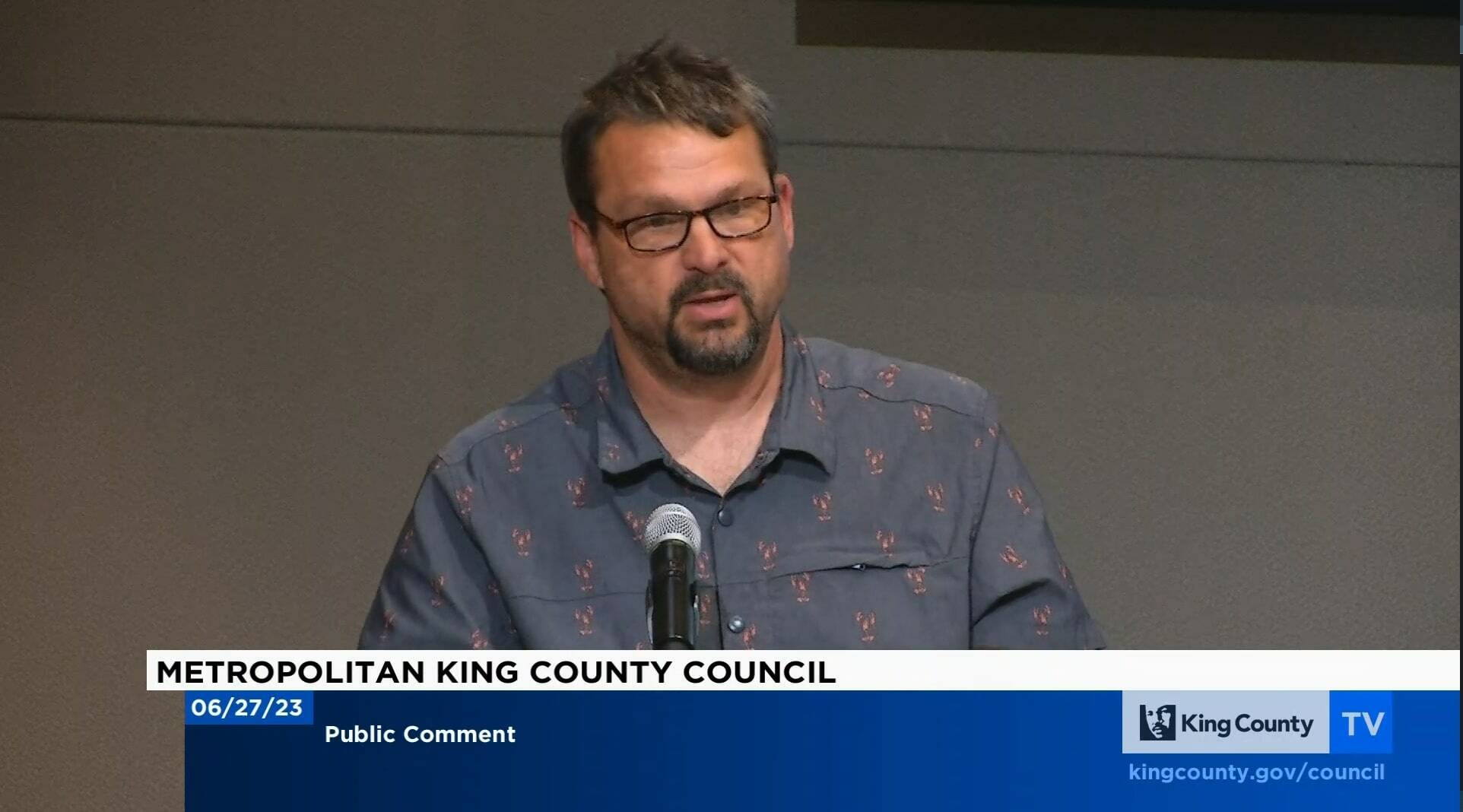Waving green and white signs reading “build right” and “save Fall City,” a dozen or so Fall City residents traveled to the county courthouse in Seattle on June 27 to speak in support of a recently implemented housing moratorium.
In response to community organizing and pushback, the King County Council approved an emergency moratorium within Fall City last month. The move halts new residential subdivisions until December.
Speaking at a public hearing, residents praised the moratorium while decrying a string of new housing developments.
“Let’s take advantage of this time we have during the moratorium to really look at the future of what Fall City can be,” Dwight Miller, a 25-year resident, told councilmembers. “We believe what makes a town like Fall City unique should not be lost to overly aggressive, high density development that is not supported by our limited services.”
Over the last few years, Fall City has seen an unprecedented number of housing projects receive permits. Taylor Development, A single developer, has spurred seven subdivisions set to add over 120 homes. Those homes are vested and not effected by the moratorium.
Residents argue the subdivisions threaten the town’s drinking water, puts strains on already thin emergency services and roads and violates the county’s prior commitment to protect rural character in Fall City.
An unincorporated town of just over 2,000 people, Fall City is one of three defined “rural towns” in King County. That label designates historically-significant areas that aren’t allowed to incorporate.
Proponents of the moratorium argue Fall City is unique compared to other areas going through similar growing pains. Over the last two decades, local and county planning documents have repeatedly cited a desire to protect Fall City’s rural character while keeping its annual growth to a minimum, residents say.
“I was one of the leaders of the last subarea plan In Fall City and we were assured by the county during that planning process that the kind of character we had, would be the character that would be achieved,” said John Chaney, a resident who was on the 2011 Fall City Subarea Planning Committee.
“I urge you to continue the moratorium and to undertake planning work that would in-fact reinforce our rural character,” he told the council.
Yet, In the midst of a regional housing crisis, stopping development in favor of preserving rural character has been questioned. While Councilmembers did not address the moratorium at the meeting Tuesday, three councilmembers voted against it last month – with one specifically citing the housing shortage.
Councilmember Sarah Perry, who sponsored the moratorium and represents East King County, has said the pause gives officials time to study resident’s concerns and decide if additional policies are needed to regulate growth in rural areas. In a text message this week, Perry said she was grateful for those who took time to speak at the hearing.
In addition to the moratorium, Perry has introduced legislation that would create a 15-month interim zoning overlay for residential parcels in Fall City. The zone would require 10,000 square foot minimum lot sizes and specific setback lengths. A vote on that proposal is expected in late 2023.
Robert Fitzmaurice, a representative for Taylor Development, told the council the situation did not meet the requirements for an emergency moratorium and called plans to introduce a temporary residential zone a “mistake.”
“We fear that this would open the door for every neighborhood group that wants to stop growth in their area to claim that they too need a special zoning designation,” Fitzmaurice said, adding later: “Taylor Development’s projects are vested to the current code and meet the requirements for rural character.”
Fitzmaurice said there had been much “confusion and misinformation” from residents regarding a host of environmental issues. At the hearing, residents frequently expressed concerns about the impacts of development on the town’s drinking water sources.
Dustin Posser, manager of the Fall City Water District, said the recent surge in permit applications for high density subdivisions, has “surprised and greatly concerned the district,” which traditionally has had one or two new water hook-ups per year.
As an unincorporated town, Fall City lacks a sewer system and is reliant on individual septic systems to treat its wastewater. Those septic systems protect the underground aquifer where the town gets its drinking water, Posser said.
Taylor’s houses are unique in that rather than using one septic system per house, each subdivisions has one large on site septic system – also known as a LOSS – that is shared by all its homes.The LOSS systems are a concern for the water district, Posser said, who are requesting the moratorium be extended until they can complete additional studies.
“Where our wellhead sits is very very close to all of these LOSS systems,” Posser said. “We’re very concerned about the impact it may have on the ground water and the aquifers below it.”
In an interview, Andrew Jones, a LOSS program supervisor for the state Department of Health who is familiar with the situation in Fall City, said LOSS systems allow for denser development and more wastewater to go through a single-area.
While they do pose more risk to water sources than a single septic system, Jones said, the state compensates by adopting stricter requirements, including annual monitoring. In Fall City, the DOH is requiring a stricter hydrological report before they establish treatment goals, he said.
Residential LOSS systems are a relatively common, state-approved form of water treatment, Jones said. If a LOSS system is approved in Fall City, he emphasized it’s with “full confidence” that is will protect the town’s aquifer.
“We want to make sure it’s protected and stays safe,” he said.


